Creating a brushing teeth sequence worksheet for kids is so important, especially for those with autism. This simple tool can really help them develop independent oral hygiene habits! 🌟 Visual aids make complex tasks easier, improve memory retention, and boost confidence through clear, step-by-step guidance. It’s all about fostering those essential self-care skills!
As parents, we know how challenging it can be to instill these habits. But with the right support, we can make a difference. Imagine your child confidently brushing their teeth all by themselves! Let’s explore this together and find ways to encourage their independence. We’re here to help you every step of the way!
A brushing teeth sequence worksheet is an essential tool for promoting oral hygiene among children, particularly those with autism who might find complex instructions challenging. By breaking down the brushing process into clear, manageable steps, this resource not only enhances understanding but also nurtures independence and confidence in young learners.
But how can caregivers effectively implement this engaging tool? It’s all about ensuring it resonates with children’s unique needs and keeps them motivated in their daily routines. Let’s explore this together!
A brushing teeth sequence worksheet is such a helpful visual aid! It breaks down the multi-step process of brushing teeth into manageable parts, making it easier for kids to follow along. For children with autism, who often find detailed directions overwhelming, this resource provides a clear structure that allows them to track their progress visually. Research shows that visual schedules can significantly boost the ability of kids with autism to learn patterns, with an impressive Tau-U effect size of 0.95 highlighting their effectiveness. By completing each task on the activity sheet, kids not only improve their memory retention but also experience that wonderful sense of achievement, which is so important for building confidence.
Establishing a consistent oral hygiene routine with these visual aids can truly enhance a young person's independence and self-care skills. The organized nature of a sequence activity fosters predictability, making it easier for kids to engage in daily tasks. Plus, using sequence worksheets has been shown to improve self-care abilities, empowering young individuals to take charge of their hygiene routines. This approach aligns perfectly with the essential components of behavioral program development, focusing on personalized support and clear progress tracking.
And let’s not forget about video modeling! This additional strategy can really help young individuals master their routines, as it has been proven to enhance functional living skills for those with ASD. When caregivers actively participate, equipped with ABA principles and strategies, it can significantly boost the effectiveness of these interventions, leading to better behavioral outcomes and informed decision-making.
While the benefits of visual aids are clear, it’s important to continue exploring their effectiveness across different populations, including preschool and secondary-school aged children. Understanding the variability in approaches and parental engagement in interventions can provide a deeper insight into how best to support individuals with autism. Including a brushing teeth sequence worksheet is a fantastic way for parents and caregivers to assist their child's growth in self-care and independence. Let’s explore this together!
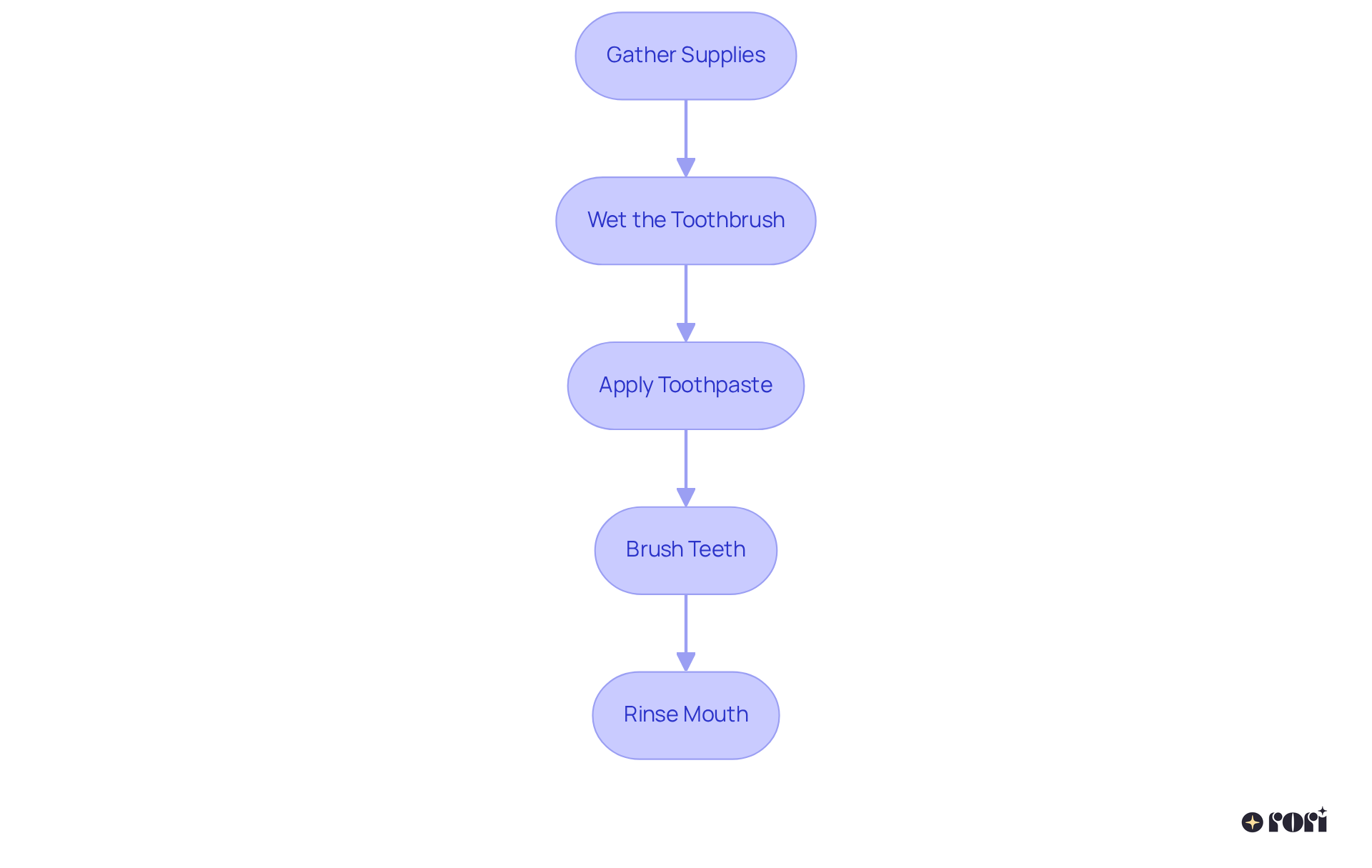
Creating a fun and engaging project involves developing an effective brushing teeth sequence worksheet! To get started, you'll need a few materials that will make the process enjoyable for both you and your little ones.
First up, consider using Paper or Cardstock. Opt for something sturdy that can handle frequent handling—after all, kids can be enthusiastic!
Next, grab some Markers or Colored Pencils. Bright colors will make your worksheet visually appealing and keep the kids excited about using it.
Don’t forget about Stickers or Stamps! These fun elements allow children to mark completed tasks, adding a playful touch to their dental care routine.
You’ll also want to gather Images or Icons that represent each step of the cleaning process. Think of visuals like a toothbrush, toothpaste, and a glass of water—these will help kids understand what to do next.
Lastly, consider using Laminating Sheets. Laminating your document can add durability, allowing for repeated use, which is perfect for busy households.
By collecting these resources, you can create a brushing teeth sequence worksheet that is both practical and captivating for children. Let’s make dental care a fun adventure together!
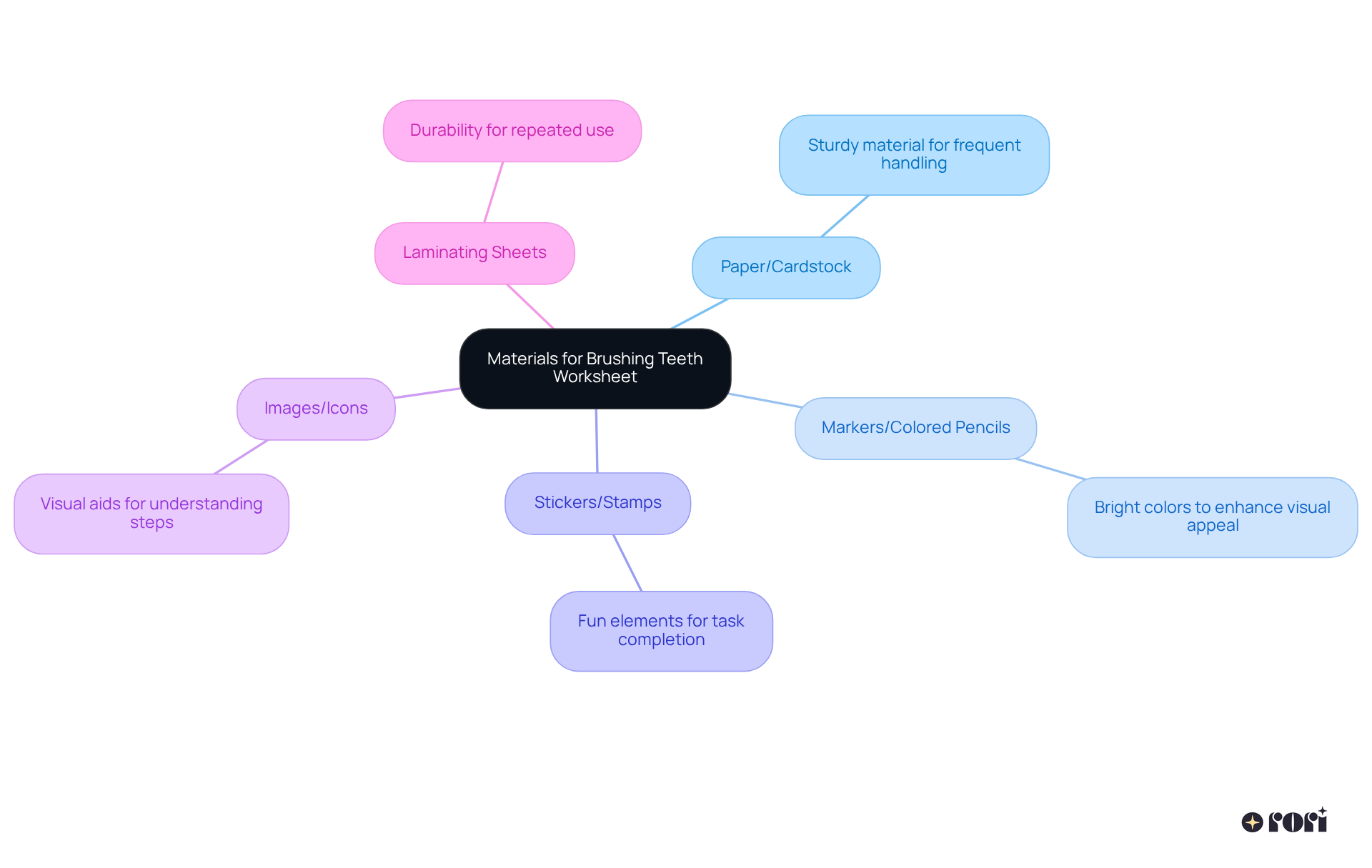
Creating a fun and rewarding brushing teeth sequence worksheet can be an effective task! Here are some essential design principles to keep in mind:
By applying these tips, you’ll create a brushing teeth sequence worksheet that is both practical and captivating. It can transform the dental care process into a positive experience for kids. Let’s explore this together and make brushing teeth a fun adventure!
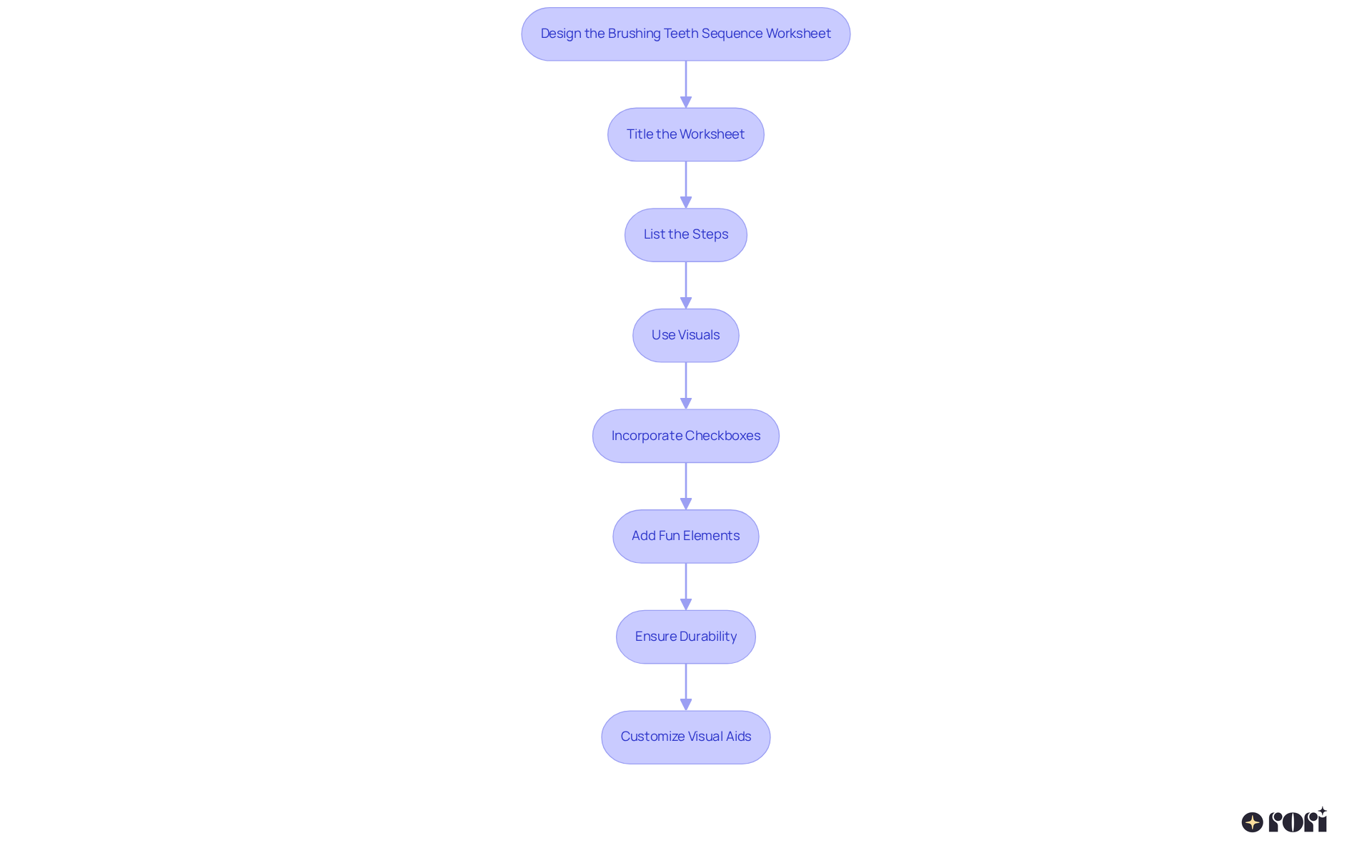
To effectively integrate the brushing teeth sequence worksheet into your child's daily routine, let’s follow these simple steps together:
Select a Steady Hour: Pick a specific time each day for cleaning teeth, like after breakfast and before bedtime. This helps establish a reliable schedule! Research shows that having steady routines is especially important for individuals with autism, as it helps them feel secure and understand what to expect.
Present the Activity: Share the purpose of this activity with your child. Explain how the brushing teeth sequence worksheet will assist them in remembering the steps for brushing their teeth. As the Annie E. Casey Foundation highlights, parental involvement is key to the success of young individuals. Clarifying the purpose can really boost their engagement! When caregivers understand ABA principles, they can make informed choices that positively impact their child's progress.
Utilize the Activity Together: At first, guide your little one through the task, pointing out each step as they complete it. This collaborative approach offers the necessary support and reinforces their learning. Did you know that video modeling interventions are effective for teaching functional living skills? It’s a practical way to enhance understanding! Active caregiver involvement aligns with therapeutic strategies, often leading to lasting behavioral improvements.
Encourage Independence: As your child becomes more comfortable with the steps, encourage them to use the brushing teeth sequence worksheet independently. This helps build their confidence and fosters self-reliance. Research shows that children who practice self-care with parental support often gain independence over time. Empowered caregivers, equipped with knowledge from Rori Care's programs, can significantly enhance their child's ability to handle self-care tasks.
Celebrate Success: After each cleaning session, take a moment to acknowledge your child's accomplishments, whether they finished the activity or successfully cleaned their teeth. Positive reinforcement is so important for maintaining motivation! Celebrating even the small wins can greatly influence a young person's willingness to engage in self-care practices, especially when caregivers understand ABA strategies.
By seamlessly integrating this activity into your daily routine, you help your child develop a consistent dental care habit, which is crucial for their oral hygiene and overall independence. Engaging in this process not only enhances their self-care skills but also strengthens the bond between you and your child. Remember, active parental involvement and caregiver education are vital in promoting youth development. Let’s explore this journey together!
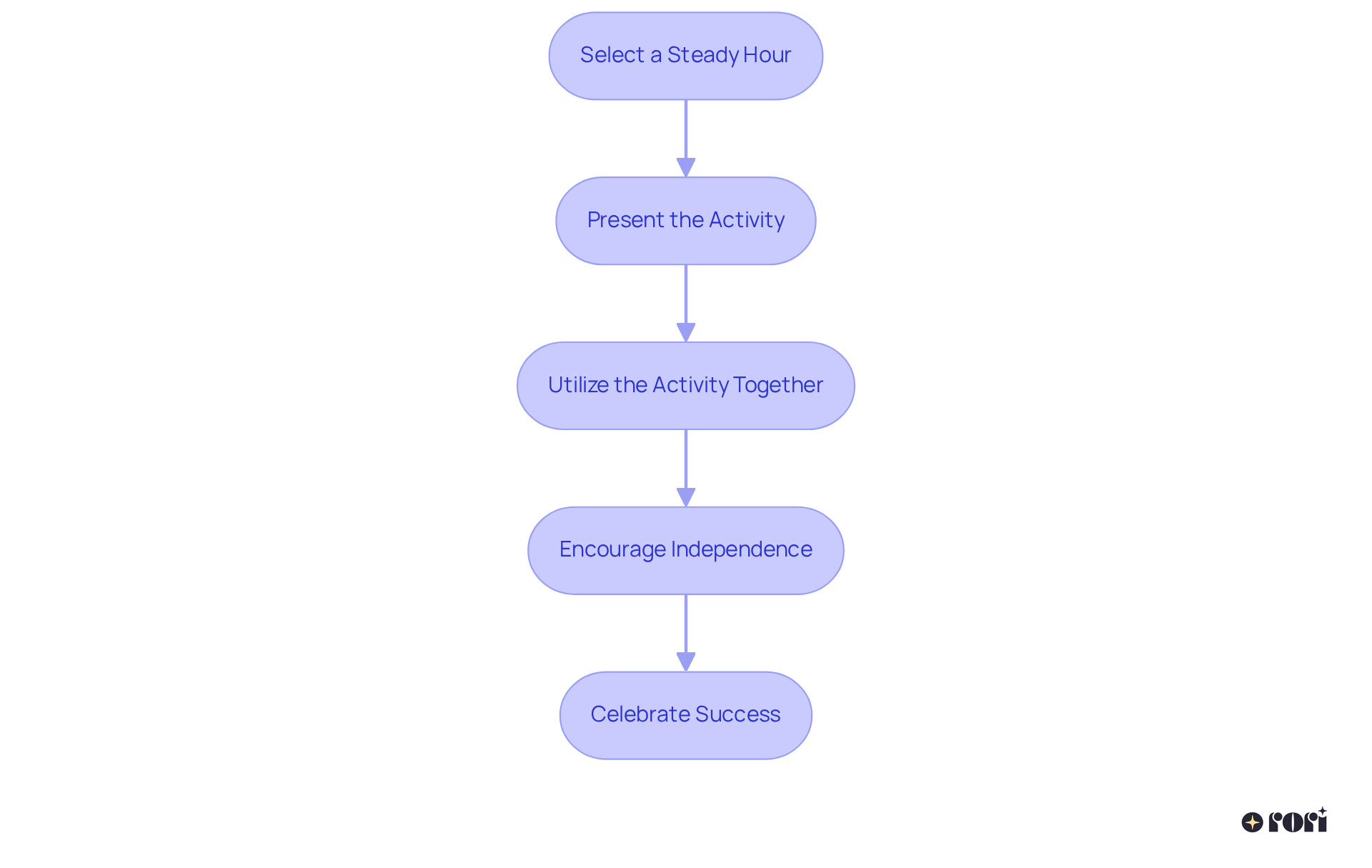
When utilizing the brushing teeth sequence document, you might encounter a few challenges along the way. Let’s dive into some common issues and explore effective strategies to tackle them together:
Resistance to Routine: If your little one seems hesitant to use the worksheet, try making it more appealing! Allow them to personalize it with decorations or their favorite stickers. This not only encourages a sense of ownership but also sparks enthusiasm, which is key to establishing effective habits.
Difficulty Following Steps: For young learners who find it tricky to follow the sequence, consider breaking down the steps even further. Incorporating additional visuals that clearly illustrate each action can make a world of difference. Visual aids are fantastic for enhancing understanding and execution, aligning perfectly with the individualized approaches we cherish in ABA therapy.
Loss of Interest: To keep your child engaged, think about updating the layout of the activity from time to time or introducing new incentives for completing the brushing routine. Changing up the rewards can reignite their enthusiasm and motivation, which is so important for maintaining interest in daily tasks.
Forgetfulness: If your child tends to forget to use the document, try setting up reminders or placing it in a prominent spot, like on the bathroom mirror. Visual cues serve as powerful prompts, helping to solidify those habits and support your child's growth.
Inconsistent Use: Encourage consistency by turning tooth cleaning into a family activity, where everyone participates in their own tasks at the same time. This collective approach not only strengthens the practice but also adds an element of fun, highlighting the importance of teamwork in autism care.
By proactively addressing these challenges, you can ensure that the brushing teeth sequence worksheet continues to be a valuable tool in your child's daily routine. Together, we can foster better oral hygiene habits and support their overall development through the principles of ABA. Let’s explore this journey together!
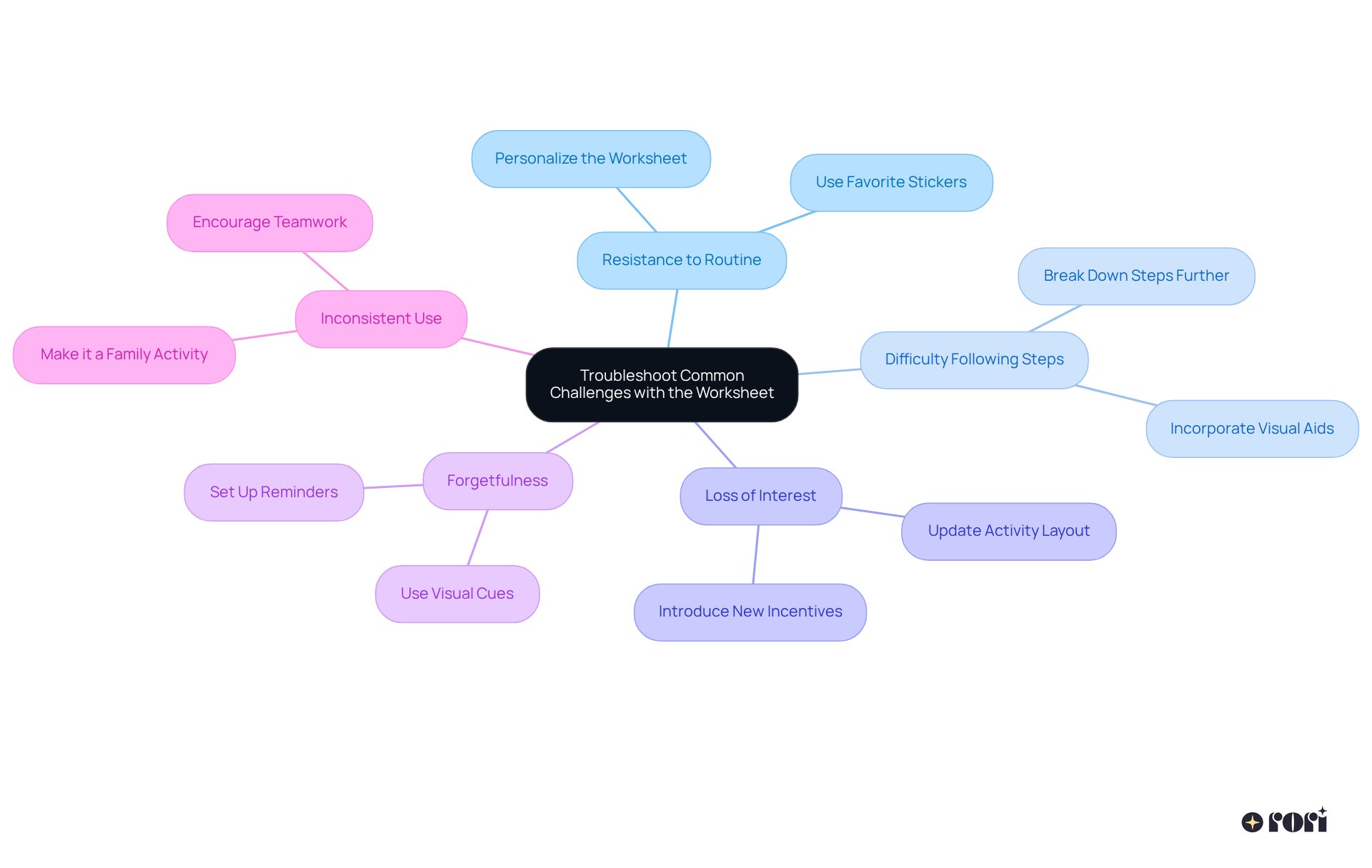
Creating a brushing teeth sequence worksheet for kids is such an important step in promoting oral hygiene and helping young learners become more independent. By breaking down the brushing process into simple steps, this resource makes it easier for children—especially those with autism—to tackle what can feel like an overwhelming task. Plus, it boosts their confidence and self-care skills!
Key insights from the article highlight how visual aids and structured routines are vital in supporting children's learning. When we combine engaging materials with clear instructions and active parental involvement, we can really enhance a child's ability to stick to their dental care routine. And let’s not forget about the common challenges—like resistance to routine or forgetfulness—that can pop up. Addressing these ensures that our brushing teeth sequence worksheet stays effective in daily life.
Ultimately, building good dental hygiene habits for children is a team effort. By using creative resources like the brushing teeth sequence worksheet, parents and caregivers can turn oral care into a fun and rewarding experience. This not only leads to better health outcomes but also strengthens the bond between caregivers and children, making every brushing session a step towards greater independence and well-being. Let’s explore this journey together!
What is a brushing teeth sequence worksheet?
A brushing teeth sequence worksheet is a visual aid that breaks down the multi-step process of brushing teeth into manageable parts, making it easier for kids, especially those with autism, to follow along and track their progress visually.
How does a brushing teeth sequence worksheet benefit children with autism?
It provides a clear structure that helps children with autism manage detailed directions, enhances their ability to learn patterns, improves memory retention, and fosters a sense of achievement, which is important for building confidence.
What are the advantages of using visual aids for oral hygiene routines?
Visual aids enhance independence and self-care skills, foster predictability in daily tasks, and have been shown to improve self-care abilities, empowering young individuals to take charge of their hygiene routines.
How can video modeling assist children in mastering their brushing routine?
Video modeling can enhance functional living skills for young individuals with ASD. When caregivers participate using ABA principles and strategies, it significantly boosts the effectiveness of these interventions, leading to better behavioral outcomes.
What materials are needed to create an effective brushing teeth sequence worksheet?
The necessary materials include sturdy paper or cardstock, markers or colored pencils for visual appeal, stickers or stamps to mark completed tasks, images or icons representing each step (like a toothbrush and toothpaste), and laminating sheets for durability.
Why is it important to explore the effectiveness of visual aids across different populations?
Understanding the variability in approaches and parental engagement in interventions can provide deeper insights into how best to support individuals with autism, including preschool and secondary-school aged children.
How can parents and caregivers use a brushing teeth sequence worksheet?
Parents and caregivers can use the worksheet to assist their child's growth in self-care and independence by providing structured guidance and support during the oral hygiene routine.